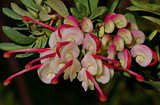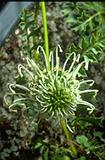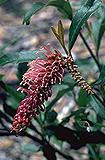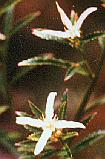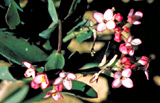|
[Front Page] [Features] [Departments] [Society Home] [Subscribe]

Protecting Threatened Plants
Jeanette Mill and Fiona Hall
Introduction
Australia is one of only seventeen countries in the world that are considered to be biologically megadiverse. There are thirteen centres of global plant diversity and endemism in Australia (Davis and Heywood, 1995). Of the 22000 species of vascular plants in Australia, 14.8 percent are globally rare, threatened or extinct, according to the IUCN Red List of Threatened Plants (Walter and Gillett, 1998). Eighty-five percent of Australia's plant species are endemic, and new species are still being discovered, like the Nightcap Oak (Eidothea sp nov), a large tree discovered only last year in northern NSW. There are possibly ten times the number of cryptogams (fungi, algae, lichens, mosses etc) as vascular plants, and we have barely begun to understand them. We have a unique floral heritage, but as we know, this is under considerable, and increasing threat.
In this paper we first outline the threats facing our native plants and their habitats. We then describe what measures are being taken to stem these threats. Finally we provide a few case studies of the types of activities being conducted to conserve our native species, and focus especially on the work being done via the Australian Network for Plant Conservation (ANPC).
Our Threatened Flora
Nationally, the statistics on the status of threatened Australian plants and ecological communities, according to the Commonwealth Environment Protection and Biodiversity Conservation Act, 1999 are as follows:
Table 1: Status of threatened Australian plants
and ecological communities
| Category |
No. species |
Ecological
communities |
No. communities |
| Endangered |
518 |
Threatened |
27 |
| Vulnerable |
656 |
|
|
| Extinct |
63 |
|
|
| Total |
1237 |
|
|
|
| Source: Environment Protection and Biodiversity Conservation Act, 1999 listings on website (29 August 2001) Commonwealth of Australia. |
These threatened species include:
- Grevillea scapigera Corrigin Grevillea
- Pimelea spicata Pink Pimelea
- Austromyrtus gonoclada Angle-stemmed Myrtle
- Phebalium equestre Kangaroo Island Phebalium
- Asterolasia nivea Bindoon Starbush
- Rutidosis leptorrhynchoides Button Wrinklewort or Canberra
Daisy
- Eucalyptus recurva (no common name)
- Swainsona recta Small Purple Pea
- Grevillea iaspicula Wee-Jasper Spider Flower
- Grevillea wilkinsonii Tumut Grevillea
- Haloragodendron lucasii Hal
- Wollemia nobilis Wollemi Pine
- Eucalyptus copulans (no common name)
- Microstrobus fitzgeraldii Dwarf Mountain Pine
The main threats include, in the following order: (Leigh and
Briggs,1992):
- Agriculture
- Grazing
- Low numbers
- Weed competition
- Road works
- Industrial and urban development
- Fire frequency
- Forestry
- Collecting
- Mining
What is being done?
- Governments are introducing legislation to identify and protect threatened plants and ecological communities.
- Biodiversity conservation strategies have been introduced right down to a local level in response to the Convention on Biological Diversity.
- Government agencies are funding and conducting research and recovery programs. There is a real need for conservation groups to get involved in the recovery planning process. Under the Environment Protection and Biodiversity Conservation Act 1999, any group of people interested in preserving a threatened species or community can form themselves
into a recovery team and then write a recovery plan. Government agencies alone can not develop all the recovery plans that are needed for the many threatened species and communities - a joint approach is the most effective and efficient way forward.
- The issue of conservation of ecological communities is being tackled - this is a very recent move, with the declaration of a number of endangered ecological communities.
- Industry is funding and carrying out research into rehabilitation, and running seminars on seed biology and best practice such as the Australian Centre for Mining Environmental Research (ACMER) Native Seed Biology for Revegetation workshops.
- Botanic gardens are cultivating, researching and educating.
- Farmers and other landholders are conserving species on their properties, and becoming actively involved in education, rehabilitation and growing.
- A multiplicity of local groups has sprouted, enthusiastically fencing, planting and protecting native vegetation.
What is ANPC doing?
The many different approaches being taken to plant conservation by such varied groups is argument in itself for the need for a national network to coordinate and integrate the work being done. Coordination and information sharing can help make the whole greater than the sum of the parts and reduce duplication of effort and waste of precious resources.
For example, the enthusiasm of, and many voluntary hours put in by, greening groups and other community groups is a vital aspect of the Australian conservation scene. However, there is a danger that without adequate links to the "bigger picture" this work could be less effective than was intended. For example, the focus of much voluntary activity is often on collecting and planting. But collection of seed and other plant material needs to be done with great care if it is not to undermine the wellbeing of target populations. And the same goes for reintroducing species back into natural habitats, as we shall see later in this talk, as well as for planting trees. For example, seed from threatened species may be collected at slightly the wrong time, there by rendering them non-viable and reducing the chances of survival of the source population. In no way do we want to dampen the enthusiasm of groups involved in conservation, but it is vital that they are armed with best practice techniques and effective links to the research and other information that can enhance their work.
This is the aim of the ANPC, whose mission is "to promote and
develop plant conservation in Australia".
The ANPC was founded in 1991 in response to a conference which discussed the state of play in plant conservation in Australia, and the need for coordination. The network has over 400 members. Integrated conservation is the focus of the network, and members represent the range of stakeholders from government, industry, community, in situ and ex situ conservation, including scientists, conservation agencies, botanic gardens, local government, land managers such as the NSW Roads and Traffic Authority, community groups, industry and individuals (Figure 1).

Figure 1. ANPC membership categories
ANPC helps all these different groups and individuals to get together (through national conferences) to learn from each other (through our newsletter Danthonia, email listserver, seminars, etc.) and to incorporate best practice approaches into their plant conservation work (through the publication of guidelines, training courses, practical workshops etc.).

Figure 2. An integrated approach to plant conservation
Source: Kingsley Dixon pers. comm.
The ANPC is all about promoting integrated plant conservation (Figure 2). This integrated approach ensures that nothing is ever done in isolation. The underpinning of the program is the alpha diversity, or taxonomy required in order to know what species is being dealt with. The top, species recovery, is the goal. The methods, the layers in the middle, are always integrated, so that genetics, germplasm storage, restoration ecology or any other work are all linked. For example, restoration ecology tells us how to put a plant back into an ecosystem, genetics tells us what to sample of a plant population for germplasm storage and eventually restoration. The process ensures the protection of key genetic resources. Everything is translated back into the field, and all work has a focus and ultimate goal of conservation and restoration in the wild.
We now present a few case studies to illustrate how this happens in practice.
Case Study 1:
Best practice guidelines for the collection of seed and other plant material
Soon after the formation of the ANPC, members noted that there were many groups conducting activities such as seed collection, storage, viability testing and dissemination. It was apparent that there was little coordinated policy regarding the collections.
In order for the collection of seed and other plant material (collectively known as germplasm) to benefit threatened species, close attention must be paid to such aspects as collection techniques and documentation. Basic genetics tell us that species vary across their range in their genetic make-up, and collecting protocols must account for correct sampling of the genetic variation to suit the end-purpose of the collection.
Other considerations include the availability of material from another source. Needless collection can only further threaten a species.
One response by the ANPC was to develop a database of ex situ collections of endangered plants to enable material to be sourced from existing collections. This database is called the National Endangered Flora Collection (ANPC, 1993). It is also an invaluable tool for accessing information and contacts with researchers and storage facilities.
| |
 |
| |
Figure 3. ANPC Translocation and
Germplasm conservation guidelines |
ANPC also formed the Germplasm Working Group, led by Dr Kingsley Dixon, Director of Science at Kings Park and Botanic Garden. Dr Dixon's program has conducted extensive research on such techniques as seed banking of threatened plants and using smoke to promote seed germination. Members of the working group were drawn from research institutions, forestry and primary industry seed laboratories, botanic gardens research centres, and conservation agencies.
The working group developed a set of guidelines (Figure 3), the Germplasm Conservation Guidelines for Australia (ANPC, 1997) which include such topics as:
- Objectives and methods of germplasm storage
- Germplasm collection protocols and methods
- Seed storage
- Vegetative propagule storage
- Documentation and databasing of collections
- Dissemination
- Seed orcharding
Cutting edge methodologies developed by member organisations, such as cryostorage of threatened plant germplasm, are covered in the guidelines, as well as in ANPC conferences and courses.
Case Study 2:
Guidelines for translocating threatened plants
Occasionally it becomes necessary to move threatened plants from one site to another, whether for re-introduction, introduction, or re-stocking. This 'translocation' should never be considered as a substitute for in situ conservation because it is a complex conservation measure which rarely succeeds, requiring good planning, correct prioritisation and long term monitoring. However, it may be the last option for the survival of critically threatened plant species, where efforts to conserve wild populations are failing (due to disease, land degradation, salinity etc).
Translocation is a complex conservation measure which can be either beneficial or detrimental to the long-term conservation of the species, and the habitat into which it is being translocated. If a translocation is unsuccessful it may be impossible to retrieve the habitat.
Translocations often fail. Some reasons for the lack of success are:
- The original threats are not adequately controlled;
- The biological and ecological requirements for the species have not been adequately considered;
- The assessment of genetic variability is often neglected; and
- Ongoing commitment of resources to monitoring and follow-up maintenance is often lacking.
As one example, Dr Andrew Young of CSIRO Plant Industry in Canberra has been studying the genetics of populations of the endangered Rutidosis leptorrhynchoides. He found that the isolated Victorian populations have a slightly different genetic make-up to the populations in NSW and the ACT (Young and Clarke, 2001). The implications of this are that if the Victorian population was used for translocation in NSW or ACT, and the populations were mixed, the result would be sterile progeny, leading to the demise of the species. This type of knowledge is vital if translocation is to succeed.
|
| The implications of this are that if....... the populations were mixed, the result would be sterile progeny, leading to the demise of the species |
|
For these reasons, it was felt that best practice technical guidance was needed for those undertaking reintroductions and other types of translocations. The ANPC formed a Translocation Working Group, comprising specialists from conservation agencies, botanic gardens and research institutions. It is chaired by Maria Matthes of the NSW National Parks and Wildlife Service. The Working Group developed the Guidelines for the Translocation of Threatened Plants in Australia.
These focus on techniques and issues once a decision to translocate has been made, and cover:
- The translocation process from project development through to monitoring;
- Biological, ecological, ex situ and logistical
considerations;
- Case studies; and
- Community participation.
The Australia and New Zealand Environment and Conservation Ministerial Council's (ANZECC) Standing Committee on Conservation supports both sets of guidelines, and has recommended adoption across all jurisdictions. They have been successfully incorporated into management practices and are influencing funding, policy and legislation implementation. For example, in NSW where the Threatened Species Conservation Act (1995) has a strong focus on the development process, land managers proposing translocations are being directed towards the Guidelines. Groups proposing translocations in funding applications to the Federal Environment Department, Environment Australia, are being required to use the guidelines in order to qualify for funding. This will be of increasing importance as changes in legislation require more stringent development application assessments for proposals which may impact on state or federally listed threatened species or ecological communities.
Case Study 3:
South West Slopes Regional Group
Our final case study is a good example of the different elements of integrated plant conservation (Figure 2) coming together in practice. The ANPC has a number of regional groups throughout Australia. They play a key role in allowing those with an interest or involvement in plant conservation to get together and share information through activities organised in their regions. These regional networks enable efficient communication of best practice information on the conservation of plants and ecological communities to be spread to agencies and groups active in on-ground works.
The ANPC South West Slopes Regional Group (NSW) is coordinated by Paul Scannell, Curator of Albury Botanic Gardens. This regional network mirrors the national membership make-up of ANPC, having developed to include farmers, urban and rural landcare groups, TAFEs and universities, the state conservation agencies, and local volunteers. It has been very active in implementing recovery actions for the Crimson Spider Orchid (Caladenia concolor). A small population of this threatened species is surviving in the Albury area. The group uses its networking skills and links with other ANPC members to take a best practice approach to the orchid's conservation which involves both in situ and ex situ conservation.
Almost five years of community-based in situ conservation activities, including fencing, dealing with weeds and rabbits, and fire management, are now bearing fruit. The orchid's habitat is starting to show signs of recovery. Erosion prone areas have begun to regenerate and bird and mammal activity appears to be on the increase. However, regular surveys and population counts have revealed up to eleven flowers of C.concolor in the best season. Such low numbers mean that coordinated networking has been urgently needed to seek expert advice for the best conservation approach. Monitoring, research and discussions with other Caladenia recovery enthusiasts is helping to develop a better understanding of the species' requirements.
In situ work is being complemented by ex situ work. Using contacts developed via ANPC, a small percentage of seed has been collected and sent to Kings Park and Botanic Garden in Perth for germination trials. Two seedlings have been successfully grown at KPBG after building up the mycorrhizal associate for the species. These plants will act as backup for the small Albury population and may be cross-pollinated by hand to obtain seed for future trials and possible reintroductions. The future management of this species will be guided by a Recovery Plan, currently being finalised by the NSW National Parks and Wildlife Service.
Future initiatives
Training, conferences and workshops are other major ways in which the ANPC promotes best practice techniques. The ANPC has developed an intensive Plant Conservation Techniques Course, inspired by the International Diploma Course in Plant Conservation Techniques run by Royal Botanic Gardens, Kew.
| |
 |
| |
Figure 4. Joe McAuliffe, Nursery Manager at the Australian National Botanic Gardens, conducts an ANPC workshop on propagation of the threatened Hakea pulvinifera. Photo: Jeanette Mill, ANPC. |
Topics covered in the course include:
- Principles and ethics of conservation
- Levels of biodiversity
- Assessing rarity
- Restoration
- Education, community awareness and partnerships
- Gathering new information, monitoring and surveying
- Conservation management techniques
- Accessing existing information, databases and literature
The course is suitable for those involved or planning to be involved in practical plant conservation projects including:
- Community volunteers
- Community support staff
- Land managers, farmers and graziers
- Industry staff
- Government staff
- Botanic gardens staff
- Facilitators and extension officers
The ANPC is also planning a series of practical, shorter workshops on themes such as ecological restoration and orchid conservation. Details of the Conservation Techniques course, and these other courses, will be posted on our , or can be obtained from the ANPC office.
Another future aim is to raise awareness of the "Forgotten Flora", the cryptogams (mosses, lichens, liverworts etc.). These plants are remarkably poorly known in Australia but are a vital part of our biodiversity. Our aim is to use posters, seminars and workshops to raise their profile and to encourage other conservation groups to give them increased
attention.
Conclusion
The challenges facing plant conservationists in Australia are many and the available resources few. But there is excellent work being done and a vast amount of knowledge out there. If we can keep talking to each other, and learning from each other's experience we can make the best of what we have and slowly start to make a difference. Having such a strong conservation component to this conference is a pleasing step in the right direction.
References
Australian Network for Plant Conservation. (1993). The National Endangered Flora Collection: A Conservation Resource. Australian Network for Plant Conservation, Canberra, ACT, Australia.
Australian Network for Plant Conservation Germplasm Working Group. (1997). Germplasm Conservation Guidelines for Australia. Australian Network for Plant Conservation, Canberra, ACT, Australia.
Australian Network for Plant Conservation Translocation Working Group. (1997). Guidelines for the Translocation of Threatened Plants in Australia. Australian Network for Plant Conservation, Canberra, ACT, Australia.
Davis, SD. and Heywood, VW. 1995. Centres of Plant Diversity. A guide and strategy for their conservation. IUCN and WWF.
Leigh, JH. and JD Briggs. (eds). (1992) Threatened Australian Plants: overview and case studies. NSW National Parks and Wildlife Service.
Walter, K.S. and Gillett, H.J. [eds] (1998). 1997 IUCN Red List of Threatened Plants. Compiled by the World Conservation Monitoring Centre. IUCN - The World Conservation Union, Gland, Switzerland and Cambridge, UK.
Young, A and Clark,G. (eds). 2001. Genetics, Demography and Viability of Fragmented Populations. CSIRO.
This article was originally presented at the ASGAP 21st Biennial Seminar which was held in Canberra, ACT, 1 to 5 October 2001.
A British citizen, Fiona Hall was Assistant Coordinator at the Australian Network for Plant Conservation. Before coming to Australia she worked for a county Wildlife Trust in Hertfordshire, providing advice to farmers on protecting and managing important wildlife habitat. She is now working from home as a freelance editor of environmental publications.
Jeanette Mill is the National Coordinator of the Australian Network for Plant Conservation, a national network of over 400 organisations and individuals from the government, industry and community sectors who are stake-holders in the conservation of Australia's flora. She is also Chair of the IUCN Species Survival Commission's Australasian Plant Specialist Group. Jeanette attributes much of her interest in plants, and nature in general, to attending Society for Growing Australian Plants (SGAP) meetings and field trips as a child.

[Front Page] [Features] [Departments] [Society Home] [Subscribe]
Australian Plants online - September 2003
Association of Societies for Growing Australian Plants
|



